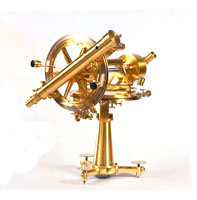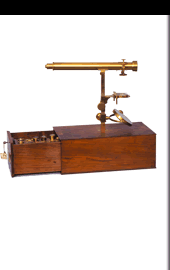Instruments
Altitude and Azimuth Repeating Circle
Amici worked on a new repeating circle from 1819 on, probably in connection with the Duke’s project to set up an astronomical observatory in Modena. There is correspondence on the matter as early as 1820 with Col. Ferdinando Visconti, Director of the Naples Royal Topographic Office, and Father Piazzi was involved as well in association with the prize offered by the Naples Royal Academy of the Sciences for the description of the best astronomical circle.
Visconti wrote Amici on 27 June, 1820: “I like your double repeating circle a lot, and those I asked about it liked it as well. The way that you invented to repeat the altitude of a star in a single instant is very ingenious and very useful at the same time. To show you that I value your work very much, I can tell you that I have decided to buy one of your double repeating circles for my Topographic Office, of the diameter of 8 inches, as you say, and with the piece added for the altitudes of the stars” (cf. A. Meschiari, Giovanni Battista Amici e il Reale Officio Topografico di Napoli. Corrispondenza con i Colonnelli Visconti, de Sauget, Melorio, “Physis”, 1-2002).
Amici read his Descrizione di un nuovo circolo ripetitore in altezza ed in azimuth (Description of a New Altitude and Azimuth Repeating Circle) on 26 March 1822 at the meeting of the Modena Royal Academy of Sciences, Letters and Arts, but it was only printed in the “Memorie” of the Academy in 1858, Volume 1, Part IV, p. 25-33 (download pdf).
Among the many advantages which the new construction offers, the Author would like to point out two above all: one is to elude the movement of the stars, and the other is that one person alone can carry out any observation, without the help of others in situating the level and in noting the time. - After having measured the simple arc by sighting the telescope on the star, the repetition is performed using the bubble level and a compound microscope which with a particular mechanism fixes the position of the telescope at the altitude where the star was at the first observation. In this way the movement of the object does not influence the repetition of the angle, and a meridian circle stably fixed on two pillars can also be used as a repeater for an arbitrary period of time. The amplifying power of the microscope used by the Author is in proportion to the power of the telescope, so that using either one or the other of these two instruments the collimating errors are equally compensated with a long series of repetitions (from the Meeting of the Section of Sciences on 26 March 1822).
 In his Elogio del Prof. Gio. Battista Amici
In his Elogio del Prof. Gio. Battista Amici
(Cellini, Florence, 1865, p. 16), Donati noted that “this multiplication, or repetition of the angles, even if it cannot obtain all of the advantages which are obtained in certain cases with the usual system, can be quite useful in decreasing the influence of the inevitable mistakes from the divisions of the circles”.
See also Paolo Brenni, Circolo ripetitore di Amici, in Gli strumenti di fisica dell’Istituto tecnico toscano – Ottica (The Physics Instruments of the Tuscan Technical Institute- Optics): http://fst.imss.fi.it/i169.html
